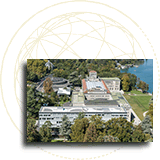Is it a bird, is it a plane?
There are a number of ways of looking at the WTO. It’s an organization for liberalizing trade. It’s a forum for governments to negotiate trade agreements. It’s a place for them to settle trade disputes. It operates a system of trade rules. (But it’s not Superman, just in case anyone thought it could solve — or cause — all the world’s problems!)
Above all, it’s a negotiating forum … Essentially, the WTO is a place where member governments go, to try to sort out the trade problems they face with each other. The first step is to talk. The WTO was born out of negotiations, and everything the WTO does is the result of negotiations. The bulk of the WTO's current work comes from the 1986-94 negotiations called the Uruguay Round and earlier negotiations under the General Agreement on Tariffs and Trade (GATT). The WTO is currently the host to new negotiations, under the “Doha Development Agenda” launched in 2001.
Where countries have faced trade barriers and wanted them lowered, the negotiations have helped to liberalize trade. But the WTO is not just about liberalizing trade, and in some circumstances its rules support maintaining trade barriers — for example to protect consumers or prevent the spread of disease.
It’s a set of rules … At its heart are the WTO agreements, negotiated and signed by the bulk of the world’s trading nations. These documents provide the legal ground-rules for international commerce. They are essentially contracts, binding governments to keep their trade policies within agreed limits. Although negotiated and signed by governments, the goal is to help producers of goods and services, exporters, and importers conduct their business, while allowing governments to meet social and environmental objectives.
The system’s overriding purpose is to help trade flow as freely as possible — so long as there are no undesirable side-effects — because this is important for economic development and well-being. That partly means removing obstacles. It also means ensuring that individuals, companies and governments know what the trade rules are around the world, and giving them the confidence that there will be no sudden changes of policy. In other words, the rules have to be “transparent” and predictable.
And it helps to settle disputes … This is a third important side to the WTO’s work. Trade relations often involve conflicting interests. Agreements, including those painstakingly negotiated in the WTO system, often need interpreting. The most harmonious way to settle these differences is through some neutral procedure based on an agreed legal foundation. That is the purpose behind the dispute settlement process written into the WTO agreements.
Born in 1995, but not so young back to top
The WTO began life on 1 January 1995, but its trading system is half a century older. Since 1948, the General Agreement on Tariffs and Trade (GATT) had provided the rules for the system. (The second WTO ministerial meeting, held in Geneva in May 1998, included a celebration of the 50th anniversary of the system.)
It did not take long for the General Agreement to give birth to an unofficial, de facto international organization, also known informally as GATT. Over the years GATT evolved through several rounds of negotiations.
The last and largest GATT round, was the Uruguay Round which lasted from 1986 to 1994 and led to the WTO’s creation. Whereas GATT had mainly dealt with trade in goods, the WTO and its agreements now cover trade in services, and in traded inventions, creations and designs (intellectual property).
Share

... OR IS IT A TABLE?
Participants in a recent radio discussion on the WTO were full of ideas. The WTO should do this, the WTO should do that, they said.
One of them finally interjected: “Wait a minute. The WTO is a table. People sit round the table and negotiate. What do you expect the table to do?”
‘Multilateral’ trading system ...
... i.e. the system operated by the WTO. Most nations — including almost all the main trading nations — are members of the system. But some are not, so “multilateral” is used to describe the system instead of “global” or “world”.
In WTO affairs, “multilateral” also contrasts with actions taken regionally or by other smaller groups of countries. (This is different from the word’s use in other areas of international relations where, for example, a “multilateral” security arrangement can be regional.)
